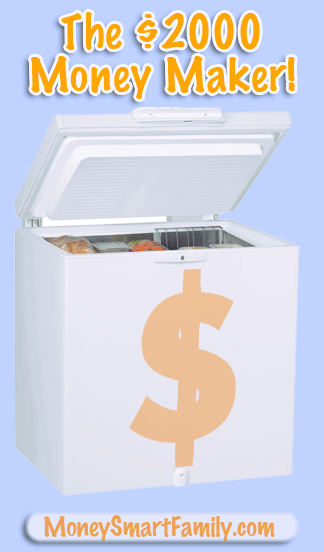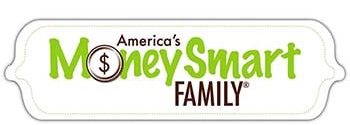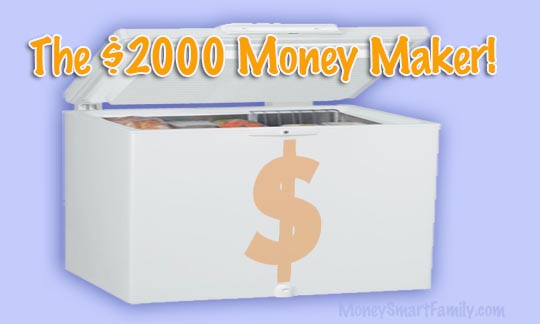Are you looking for a list of foods that freeze well? Do you want to stock up on sale items and turn your freezer into a huge money saver for your family?
Those are great goals. And we’ve got the answers for you.
The $2000 Chest Freezer is the final article of a 5 Kitchen Tools series designed to empower you to save thousands of dollars on your food budget.
Over the past few weeks, we’ve shared how we save with the humble SpoonUla, a set of glass bowls for lunches, a slow cooker, and a Meat Slicer. We’ve calculated the annual savings from using these four kitchen tools to be about $4500.
But, hold on to your wallet, we’ve held back the biggest savings for last.
This tool will assuredly pay for itself quickly and truly help you build a stockpile of cold, hard cash.
TABLE OF CONTENTS
- 1 Save Money on Your Grocery Budget with a Freezer
- 2 What Kind of Freezer Should you Buy?
- 3 Should you buy a new or used freezer?
- 4 How to Organize Your Freezer
- 5 Using the Food in Your Chest Freezer
- 6 Food Items You Can Freeze
- 7 The Food Freezing Guide
- 8 FREEZE AFTER COOKING
- 9 WON’T FREEZE WELL
- 10 Freezer Organization Tip from a Reader
Save Money on Your Grocery Budget with a Freezer
A freezer is one of the best money-saving tools a family can invest in.
Why?
Because a freezer allows you to stock up on sale items and enjoy eating steeply discounted food for weeks or months to come. We regularly freeze bread, milk and shredded cheese. But we also stock up on things like turkeys at Thanksgiving, hams at Christmas, corned beef after St. Patrick’s Day and pork ribs over the summer holidays.
Plus, because we have the storage space, we’re constantly watching for marked-down meat prices when grocers have overstocks – recently we bought 60 pounds of chicken legs for $.19 per pound.
What Kind of Freezer Should you Buy?
We like non-frost-free chest freezers because they don’t dry out food as quickly.
Frost-free freezers have a fan that constantly runs to reduce the build-up of frost. However, that same fan removes moisture from food that isn’t vacuum sealed.
Years ago we started with a 9 cubic foot chest freezer, then graduated to a 17 cubic-foot upright. Now we have a 27 cubic foot chest freezer.
We also like chest freezers more than upright freezers, as most upright freezers are frost-free, and we prefer not to have that feature.
Should you buy a new or used freezer?
This is a great question. We’ve done both – bought used and new. The key is to know what you have to spend and to patiently look for a deal.
Buying a Used Freezer
Freezers can easily be found gently used on CraigsList. Our book, “Cut Your Grocery Bill in Half with Americas’ Cheapest Family,” describes our secrets to researching and buying quality used appliances, very inexpensively. In the book, we also provide a list of the best items to freeze and how to organize a chest freezer for maximum efficiency.
Buying a New Freezer
You can also pick up inexpensive freezers from Amazon – if you’re a Prime member, shipping is free – and that makes it really affordable. Here’s a list of Amazon’s best-selling chest freezers. They aren’t that expensive, ranging in price from $199 to about $320.
Savings: We’ve calculated that our chest freezer saves us at least $2000 a year—not bad for a $400 investment. And this cool little workhorse will keep saving you money year after year, after year.
How to Organize Your Freezer
Watch this video where Annette explains how we use canvas bags to keep our freezer organized and easy to access.
Using the Food in Your Chest Freezer
If you have a freezer stocked with food, but don’t keep track of what you have, that’s a problem.
Doing a monthly inventory of your freezer will:
- Keep you on top of what you have in stock
- Help you use what you have
- Keep foods from going bad
- Save you even more money
Read how we inventory our freezer here.
Food Items You Can Freeze
One of our greatest tools for saving on groceries is our freezer. Learning which foods freeze will make your freezer even more valuable.
Over the years, as our family has grown, so has the size of our freezer. We started with a used 9-cubic-foot chest freezer, then five years later purchased a used 17-cubic-foot upright. Now we have a 27-cubic-foot chest freezer that we purchased at a steep discount when our local Montgomery Wards went out of business.
A mainstay of our money-saving philosophy is buying storable food on sale — stocking as much as we can — and slowly depleting that supply over several months. We trust that another great sale will come along by the time that stockpile is used up. Our goal is to always eat food purchased at its lowest price. Our ancestors had to rely on smoking meat, root cellars and canning to preserve their food so they could survive from harvest to harvest. Ours is not a battle for survival, but a fight to keep our food expenses low.
We’re often asked, “What can you freeze?” Our answer is, “Just about anything—if you know how.” Below is a compilation of foods we have frozen, successfully and unsuccessfully. If you know of others that work too, please let us know.
Four keys to successful freezing food are:
1) Keep air out— Air dries out food, giving it that unpleasant “freezer burn” flavor. Using multiple layers of plastic wrap or a vacuum sealer prevents this (we don’t use one, but know a few people who swear by them.)
2) Containers— Beyond plastic wrap, we employ a variety of plastic containers. Try to fill the container as much as possible to minimize air, but still allow for expansion. These containers are fine for short-term storage (1 to 2 months).
3) Minimize moisture— Moisture forms ice crystals that, when thawed, can turn absorbent foods soggy. This is especially true with breads and muffins. Cool them completely before freezing and double bag whenever possible. When defrosting, add a paper towel inside the bag to absorb moisture. Read this popular article: How to Freeze Store Bought Bread
4) Blanching— most vegetables and some fruits will not freeze well unless they are cooked first. Blanching is the process of lightly cooking by boiling for a brief period of time (2 to 10 minutes). Most basic cookbooks describe this process. If you overcook and then freeze, the veggies will be very mushy when defrosted.
| EASY OR HARD TO FREEZE | ITEM | SPECIAL INSTRUCTIONS |
| EASY | Baking Chocolate / Coconut | Just keep it wrapped up airtight. |
| EASY | Bananas | Freeze old bananas, in the skin or out. Put in a zippered bag for use later in banana bread, smoothies or pancakes. If you fully defrost a frozen banana in the skin it’s hard to peel them because they are so mushy. |
| EASY | Berries | Strawberries, raspberries, brambleberries, blueberries, blackberries and other miscellaneous berries all freeze well. Rinse and store in zippered bags in small quantities. |
| EASY | Birthday Cake | If you make too much, wrap in plastic wrap and free it for later |
| EASY | Bread, Bagels and Muffins | Minimize condensation. Double-bagging and removing as much air as possible are the keys. We pack three loaves to a plastic grocery bag, tie the top and set it gently in the freezer. Once frozen, it can be located elsewhere in the freezer. Try not to crush it by placing under heavier items. We buy whole wheat bread — it’s denser than white bread, contains less moisture and has fewer problems when defrosting. |
The Food Freezing Guide
Berries
Strawberries, raspberries, brambleberries, blueberries, blackberries and other miscellaneous
berries all freeze well. Rinse and store in zippered bags in small quantities.
Birthday cake
If you make too much, freeze it for later.
Bread, Bagels and Muffins
The goal here is to minimize condensation. Double-bagging and removing as much air as possible are the keys. We pack three loaves to a plastic grocery bag, tie the top and set it gently in the freezer. Once frozen, it can be located elsewhere in the freezer. Try not to crush it by placing under heavier items. We predominantly buy whole wheat bread — it’s denser than white bread, contains less moisture and has fewer problems when defrosting.
Cheese
We freeze mostly shredded cheese, but, on occasion, solid chunks. Chunk cheese will crumble when thawed out. Ricotta cheese freezes OK; when defrosted, water may separate and need to be mixed back in or dumped out.
Drinks
Fruit juice, lemonade, tea and coffee all freeze well. Allow expansion room.
Flour, Corn Meal, Brown Rice, Sunflower and Flax Seeds
Freezing keeps these items from getting buggy or becoming rancid.
Fruit
We’ve frozen sliced peaches and nectarines without any cooking preparation. Use later in smoothies. Apples need to be cooked first, then frozen.
Green Onions
We buy several bunches at a time and chop into small pieces, then store in a zippered bag. Cilantro and parsley can also be stored this way.
Lemons
We juice our lemons and freeze in ice cube trays, then remove from the tray and store in zippered bags. We haven’t had any luck with freezing juiced oranges or grapefruits the juice separates from the pulp and tends to get bitter when thawed.
Lunch Meat
We find great bargains when items are a couple days from going “out of code.” Can be stored for months. Hot dogs also fit in this category.
Margarine / Butter
Freeze as is — but don’t drop it on your toes when it’s frozen!!
Meat
Just be sure it is wrapped well — no tears. If you’re going to store for longer than a few months—double wrap. Beef, pork, chicken, lamb, fish — all freeze well. Our best deals have been on meat that is close to code. According to experts, fish doesn’t freeze well for long periods of time.
Milk
Tap off about one cup from a gallon jug to allow for expansion when it’s frozen. To defrost in the winter, we place it in the sink overnight. In the summer, we place it in the sink, then shake it every hour and place in refrigerator when half-defrosted. For quick thawing, microwave for seven minutes or less; shake using a potholder (the milk in the handle of a one-gallon container can get hot). Repeat the previous step if necessary. Shake before serving to mix in separated fat.
Nuts
Store in sealed plastic bag or container. Keeps them from going rancid on the shelf. Test before including in recipes if stored for more than six months.
Snickers Bars
Frozen is the ONLY way to eat ’em.
Turkeys
Since frozen ones come vacuum-sealed, they can be stored easily for a year and possibly longer. One butcher who served in the Navy said that they often shipped out with two years’ worth of frozen Thanksgiving turkeys on board.
FREEZE AFTER COOKING
Eggs
Scramble raw eggs and freeze in small containers. Be sure to label how many eggs are in the container.
Mushrooms
If they’re on sale, we buy several pounds, clean, slice and cook in a wine and butter sauce. Then store in smaller containers for later use.
Pasta
Must be under cooked. Store in zippered bag or plastic container.
Potatoes
Must be thoroughly cooked or else they’ll turn black — we learned this the hard way.
Rice
Cooked, but not overcooked. Store in zippered bag or plastic container.
Soups
Cook it up, cool it down, ladle into a container and leave some space for expansion.
Spaghetti Sauce
Cook it up, cool it down, ladle into a container and leave some space for expansion.
Veggies
Unless buying flash-frozen from the store, these must all be cooked first (i.e. blanched). Beets, broccoli, carrots, cauliflower, celery, corn, green beans, spinach and Swiss chard all freeze well.
WON’T FREEZE WELL
Cream Cheese
Doesn’t freeze well because it gets lumpy, crumbly and watery. You can reconstitute it by using a blender, but it still won’t be as good as fresh stuff.
Eggplant
Turns rubbery and leaks water even after it is cooked.
Melons
Don’t know how they do it in the frozen food section (it must be flash frozen); it just hasn’t worked for us.
Salad Vegetables
Lettuce, cucumbers, radishes and cabbage. Water in the cells of the vegetables expands when frozen and bursts the cell walls. When the food is thawed, the liquid seeps out and the food becomes limp. We’ve read of some people taking wilted lettuce and using it in a soup recipe.
Whipping Cream
It gets grainy and won’t whip up smooth after being frozen. Can be used in cooking recipes, but not for frosting and other whipped applications. If you must store, whip it first, then freeze in small quantities.
Freezer Organization Tip from a Reader
I just reorganized my freezer using plastic bins. It’s great and really easy to find what I need. I marked them “Beef,” “Chicken” and “Pork.” This has really helped me to know what I already have in the freezer so I can shop more carefully. Leslie Wilson – Jacksonville, FL
If you missed any of the posts in this series, you can catch up here.
- Week 1: The Humble SpoonULa
- Week 2: $1000 Lunch Hack
- Week 3: $3400 Crock Pot
- Week 4: $500 Sliced Savings
- Week 5: $2000 Freezer Tool
This TV spot describes the five tools in a little more detail.



Why buy a new freezer, when there are lots of cheap used ones out there? I bought a large chest freezer second hand for $40; same size as you say cost $2000 new.
Humester – We DO advocate buying a used freezer and have done this very thing a number of times in the past 40 years. I think you may have misunderstood the focus of our article – we are NOT saying that you should spend $2000 for a freezer …. we ARE SAYING that buying a freezer (used or new) could SAVE YOU $2000 Each Year.
Hope this helps.